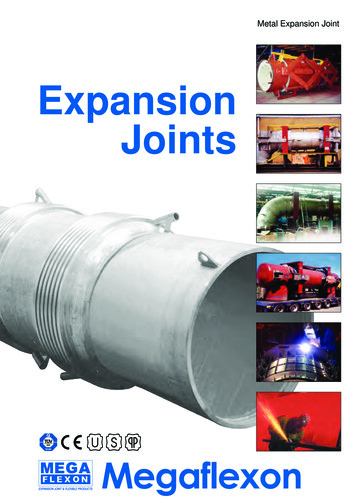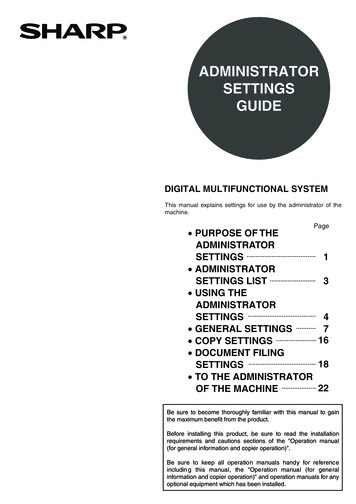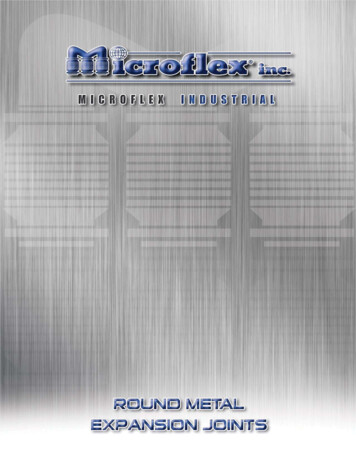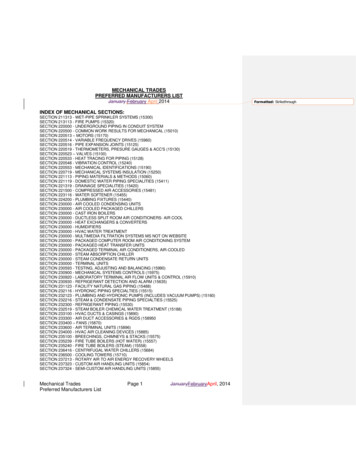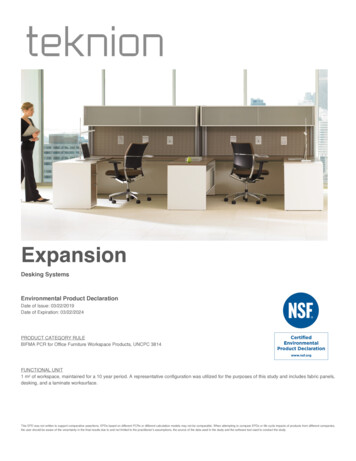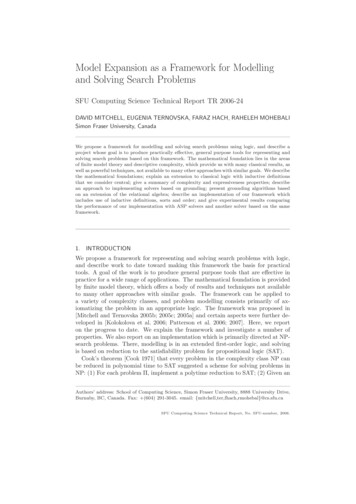
Transcription
Model Expansion as a Framework for Modellingand Solving Search ProblemsSFU Computing Science Technical Report TR 2006-24DAVID MITCHELL, EUGENIA TERNOVSKA, FARAZ HACH, RAHELEH MOHEBALISimon Fraser University, CanadaWe propose a framework for modelling and solving search problems using logic, and describe aproject whose goal is to produce practically effective, general purpose tools for representing andsolving search problems based on this framework. The mathematical foundation lies in the areasof finite model theory and descriptive complexity, which provide us with many classical results, aswell as powerful techniques, not available to many other approaches with similar goals. We describethe mathematical foundations; explain an extension to classical logic with inductive definitionsthat we consider central; give a summary of complexity and expressiveness properties; describean approach to implementing solvers based on grounding; present grounding algorithms basedon an extension of the relational algebra; describe an implementation of our framework whichincludes use of inductive definitions, sorts and order; and give experimental results comparingthe performance of our implementation with ASP solvers and another solver based on the sameframework.1.INTRODUCTIONWe propose a framework for representing and solving search problems with logic,and describe work to date toward making this framework the basis for practicaltools. A goal of the work is to produce general purpose tools that are effective inpractice for a wide range of applications. The mathematical foundation is providedby finite model theory, which offers a body of results and techniques not availableto many other approaches with similar goals. The framework can be applied toa variety of complexity classes, and problem modelling consists primarily of axiomatizing the problem in an appropriate logic. The framework was proposed in[Mitchell and Ternovska 2005b; 2005c; 2005a] and certain aspects were further developed in [Kolokolova et al. 2006; Patterson et al. 2006; 2007]. Here, we reporton the progress to date. We explain the framework and investigate a number ofproperties. We also report on an implementation which is primarily directed at NPsearch problems. There, modelling is in an extended first-order logic, and solvingis based on reduction to the satisfiability problem for propositional logic (SAT).Cook’s theorem [Cook 1971] that every problem in the complexity class NP canbe reduced in polynomial time to SAT suggested a scheme for solving problems inNP: (1) For each problem Π, implement a polytime reduction to SAT; (2) Given anAuthors’ address: School of Computing Science, Simon Fraser University, 8888 University Drive,Burnaby, BC, Canada. Fax: (604) 291-3045. email: {mitchell,ter,fhach,rmohebal}@cs.sfu.caSFU Computing Science Technical Report, No. SFU-number, 2006.
2·Mitchell, Ternovska, Hach and Mohebaliinstance of Π, apply the reduction to produce a propositional formula, then run thebest SAT solver available to find a satisfying assignment (thus solution) if there isone. This was almost universally considered an idea of purely theoretical interest,but recent progress in building and applying SAT solvers shows that reduction toSAT can be an effective practical technique.Fagin’s theorem [Fagin 1974] showed that the first step, designing and implementing a reduction, can be replaced with declarative modelling. The theorem says thatNP consists exactly of those problems that can be axiomatized in existential secondorder logic ( SO). The solving scheme becomes: (1) Axiomatize problem Π with SO formula φ; (2) Given instance π of Π, check if π φ. A possible implementation of (2) is by reduction to SAT. Results analogous to Fagin’s followed for othercomplexity classes, most notably for P [Immerman 1982; Vardi 1982; Livchak 1983].This study of the relationship between logical definability and complexity is calleddescriptive complexity [Immerman 1999]. The results show that logics can be seenas modelling languages for problems in corresponding complexity classes — anotheridea that has widely been considered of theoretical, but not practical, interest.The main idea of our approach to search derives from these results, and is verysimple. Our method involves two components, a finite structure A, and a formulaφ over a larger vocabulary. Vocabulary symbols of the formula which are notinterpreted by A are second-order free variables. Search is formulated as the taskof expanding the given structure A to the vocabulary of the formula, producing amodel of the formula. We call the task model expansion, abbreviated MX.A natural way to model a search problem is to view φ as a problem description. Inthis view, instances are finite structures. The formula, which is fixed, specifies therelationship between an instance and its solutions. We construct structures B whichexpand A to the vocabulary of φ, and satisfy φ. The solutions for an instance A aregiven by the interpretations in each expansion structure B of vocabulary symbolswhich are not interpreted by A. This view clearly separates problem descriptions(formulas in some logic), from instances (finite structures), and matches with thedescriptive complexity results mentioned: Fagin’s theorem tells us that a searchproblem can be expressed this way with first-order logic (FO) if, and only if, itsassociated decision problem is in NP. Combined with a reduction from FO modelexpansion to SAT, we have a universal method for modelling and solving NP-searchproblems. Figure 1 illustrates the architecture of a solver based on this scheme.Other descriptive complexity results provide similar universal methods for a numberof other complexity classes.The formulation just described has many desirable properties. Yet, there areapplications where it seems more convenient to describe certain properties of theinstance with a formula, rather than in a structure. In this case, we may considera combined MX setting, in which an instance consists of both a formula and astructure. In this setting, the formula may be a conjunction of too parts, of whichone is fixed, and the one varies with the instance. We do not consider this settingat length here, but we do describe it’s expressiveness and complexity and give anexample in Section 2.The foundation of our approach in descriptive complexity gives us an importantadvantage over several similar approaches which are based on logics with nonSFU Computing Science Technical Report, TR 2006-24, 2006.
Modelling and Solving Search Problems with LogicProblem Specification: φ·3Instance: σ-structure A?Parse & Ground?Propositional Formula: GND(φ,A)?Propositional Solver?SolutionFig. 1.Solving-by-Grounding Scheme for NP-Searchclassical semantics. All similar systems we know of restrict the user’s syntax, oftenquite severely, to ensure efficient implementation. Limits apply, for example, toquantifier alternations, function symbols, formula depth, negation, recursion, etc.In our view, all of these are useful syntactic devices. We prefer to restrict thelanguage available as little as possible, leave the question of how liberally the syntaxmay be used in practice to practical experience. Allowing very general syntax makesimplementation more work, but we are not very concerned that such features will be“over-used”, since people, as well as programs, do not deal very well with complexaxioms.We do not suggest language restrictions are never useful, but when we apply themwe want specific, measurable benefits. In our framework, descriptive complexityresults allow us to fine-tune our languages for desired complexity classes, withoutimposing ad-hoc restrictions on syntax. For example, we will discuss the benefitto grounding-based solvers of writing axioms in the k-guarded fragment of FO,GFk [Patterson et al. 2006; 2007].An interesting property of our approach is that, under certain conditions, MXrepresentations can exactly capture a user’s intentions regarding what constitutesa solution. That is, if the user chooses a certain vocabulary for describing instancesand their solutions, an MX axiomatization can always be provided using only thisvocabulary. While a user may find use of additional “auxiliary” vocabulary symbolshandy, their use is not necessary. The property is of practical interest because asolver may have to construct interpretations for all expansion symbols, so use ofauxiliary symbols appears to imply more work for the solver. The property isalso interesting because it establishes a notion of capturing search that is slightlydifferent from the usual notion of capturing a complexity class, which applies todecision problems. In particular, FO model expansion does not capture NP-searchin this sense, but FO(LFP) model expansion, in the presence of order, does. Itis interesting that adding induction does increase expressive power when when weconsider decision problems, but it does when we consider search.SFU Computing Science Technical Report, TR 2006-24, 2006.
4·1.1Solving Search Problems with Logic: Main IdeasMitchell, Ternovska, Hach and MohebaliHere, we present a (rather myopic) history of ideas in logic-based approaches tosearch. We restrict our attention to approaches that are intended as general-purposemethods for representing and solving search problems. We compare a number ofimplemented systems with ours in Section 8.1.1.1 Search as Validity Checking. Our approach is natural in light of descriptive complexity results, but is not typical. Historically problem solving in logic wasoften cast as validity checking, as in the influential work of Green [Green 1969].There, the user axiomatizes the claim that a solution exists, and a resolution theorem prover produces, as a side-effect of proving the claim, a term describing thesolution. This idea was the basis of much later work on search in artificial intelligence1 , and on general-purpose planning systems in particular. Such approachesfound many obstacles, leading to frequent rejection of predicate logic as a suitablebasis for practical problem solving. Standard tasks such as validity and satisfiabilityare undecidable for first-order logic (FO), although it is not expressive enough evento describe such basic properties as transitive closure or reachability. Attempts tobuild practical tools often met with serious performance problems.1.1.2 Solving by Reduction: Propositional Model Finding. In contrast to the experience in building general-purpose planning systems based on Green’s scheme, itwas shown in the 1990’s that that reduction to SAT and application of a generalpurpose SAT solver was more effective than special-purpose planning programs ofthe day [Kautz and Selman 1992]. SAT-based techniques are currently the best, oramong the best, in several categories of the annual International Planning Competition [Gerevini et al. 2006]. Reduction to SAT has also been shown to be aneffective method for model checking (perhaps better called bug-finding) in hardware verification [Biere et al. 1999]. SAT-based “bounded model checking” (BMC)is now standard in the electronic design industry, and of growing importance insoftware verification. Implementations of other logic-based tools routinely eitheruse a SAT solver as the core engine, or implement variants of SAT solver methods.An attraction of basing systems on SAT solvers is that performance of standardSAT solvers improves regularly, and one can generally “plug in” the latest andbest. SAT solvers are currently effective in a number of domains, and recent worksuggests much more potential.A number of related approaches to general problem solving are based on moreexpressive languages than propositional CNF formulas. These include finite-domainconstraint satisfaction (CSP), satisfiability modulo theories (SMT), conjunctions ofPseudo-Boolean constraints, etc. These primarily address the problem that manyconstraints are not easily or concisely expressed as propositional CNF, but generallyfollow the same reduction-based paradigm.1.1.3 Separation of Instance from Problem Description. When solving a problem by reduction to SAT, normal practice is to describe the propositional formulasproduced by the reduction using informal schemata, and then implement the reduction, typically in C or C . For problems that are very simple to state, this may1 Itis also the basis of the Prolog programming language.SFU Computing Science Technical Report, TR 2006-24, 2006.
Modelling and Solving Search Problems with Logic·5be an adequate methodology. However, real applications tend to involve messy orless intuitive features, and producing a correct reduction and implementation mayrequire some effort. Worse, in practice solver efficiency may be very different underdifferent reductions. Choosing among the many basic ideas for a reduction, and themany variants of each, must be done experimentally. Thus, to achieve good performance on challenging instance families, one may need to produce and implementmany reductions. Since there are not standardized or formal tools to describe andimplement reductions, this is a time-consuming and error-prone process. One suspects that better performance would be obtained over a wider range of applicationsif such tools were available.For this and other reasons, researches in several areas have argued for methodswhich provide modelling languages, in which one describes the problem independently of particular instances. A solver takes as input a pair consisting of a problemspecification and a distinct instance description. NP-SPEC [Cadoli et al. 2000] wasamong the first proposals for a logic-based system which makes this distinction. InAnswer Set Programming (ASP), some authors have argued for the importance ofthis separation [Marek and Truszczynski 1999]. Formally, though, both parts areformulas (logic programs), and the distinction is made only as a convention, and itis not fully followed. In CSP, there a number of proposals, such as Essence [Frischet al. 2007], although there is no widely-used standard to date.1.1.4 Expressive Logics as Languages for Modelling Search. The logics proposedfor modelling languages have been primarily non-classical, presumably because ofthe practical need for recursion. For example, the language of NP-SPEC [Cadoliet al. 2000] is based on Datalog, and ASP [Niemela 1999; Marek and Truszczynski1999] is based on the language of logic programming with stable model semantics[Gelfond and Lifschitz 1991]. (It is curious that non-logic-based languages, such asESRA and Essence, typically have no construct to express recursion.)We believe that classical logic should be used for modelling to the greatest degree possible, and that recursion is essential for natural modelling. ID-logic is alogic which augments classical logic with a non-classical construction to representinduction, developed in [Denecker 2000; Denecker and Ternovska 2004b; 2007b].The construct allows for natural modelling of monotone and non-monotone inductive definitions, including iterated induction and induction over well-founded order.Such constructions occur in mathematics, as well as in common-sense reasoning.The logic is suitable to model non-monotonicity, causality and temporal reasoning[Denecker and Ternovska 2004a; 2007a], and as such is a good knowledge representation language. FO(ID) is the fragment of ID-logic in which the classical part isFO. We proposed this as the logic of choice for modelling NP-search problems asmodel expansion in [Mitchell and Ternovska 2005b; 2005c]. East and Truszczynski’s system ASPPS [East and Truszczynski 2004] may be viewed as a precursor ofour work in the sense that it is the first implemented system for solving NP-searchproblems whose modelling language may be seen as a restriction of FO(ID) to alanguage of propositional schemata with rule-based notation and positive induction.1.1.5 Herbrand versus non-Herbrand Model Finding. All general-purpose logicbased systems for search we know of are based on Herbrand model finding. ThisSFU Computing Science Technical Report, TR 2006-24, 2006.
6·Mitchell, Ternovska, Hach and Mohebaliapproach has its roots in automated theorem proving, and became prevalent in logicprogramming. In the presence of function symbols, many computational problems,including model expansion, become undecidable if formulated in terms of Herbrandmodels. This is one reason we did not adopt Herbrand reasoning in our proposal.1.1.6 Capturing Complexity Classes. Almost all known to us logic-based systems which express exactly the search problems in NP are based on non-classicallogic. Perhaps the first such proposal is due to [Cadoli et al. 2000] called NP-SPEC,which used an extension of Datalog as a modelling language. For results on expressiveness and complexity of ASP we refer the reader to [Marek and Truszczynski1999; Marek and Remmel 2003; Leone et al. 2006]. We have recently learned aboutthe diploma project by Alban Rrustemi, under the supervision of Anuj Dawar,which explores a solving scheme very similar to ours, SO as the representationlanguage, and a reduction to SAT [Rrustemi 2004].1.2MX Solver ImplementationTo demonstrate feasibility of our approach, we have implemented a solver forFO(ID)-MX, which — when applied in the parameterized setting — solves precisely the NP-search problems. There are many possible ways of building a solverfor FO(ID) MX. One could, for instance, directly implement a search for desiredstructures. Alternately, one may use a generic reduction to SAT, or some other simple NP-complete problem, and then use a program for solving this problem. Evenhaving made this choice, there are several options for the “target problem”, andfor how to carry out the reduction. For example, FO(ID)-MX could be reducedto SAT, but a reduction that captures the semantics of non-monotone inductivedefinitions is non-trivial (See [Pelov and Ternovska 2005]). Alternately, one couldreduce to an extension of propositional logic with inductive definitions, but buildinga propositional solver for this language is complex (See [Mariën et al. 2005; Mariënet al. 2006]).In our current implementation, called MXG, we perform a reduction to SAT, andside-step the complexity of dealing with arbitrary inductive definitions by handlingonly a “well-behaved” fragment, in which each definition can either be used tocompute the defined predicate during grounding, or replaced with its completion[Clark 1978], which is a classical formula. The features of our implementationinclude multiple sorts, ordered structures, bounded quantifiers, etc.1.3Paper OutlineIn Section 2 we give formal preliminaries and key definitions, and examine somebasic properties of model expansion. We review FO(ID), the extension of FO withinductive definitions and describe the main features of our approach which includethe use of multi-sorted logic and ordered structures. In the Section 3, we definedand explain our notion of capturing search. Section 4 defines and discusses grounding for MX, describes a grounding algorithm based on an extension of the relationalalgebra, and explains the result of [Patterson et al. 2007] on grounding for the kguarded fragment. Section 5 presents what we know about the complexity andexpressiveness of MX for various fragments and extensions of FO, along with thesesame properties for the related tasks of finite satisfiability and model checking asSFU Computing Science Technical Report, TR 2006-24, 2006.
Modelling and Solving Search Problems with Logic·7described in [Kolokolova et al. 2006]. Section 6 describes our current implementation. Section 7 provides a comparison of the performance of our implementationwith ASP systems and with MidL [Mariën et al. 2005; Mariën et al. 2006], anothersolver for FO(ID) model expansion. Section 8 compares our system with a number of related systems, and Section 9 offers some concluding remarks and discussesfuture work.2.2.1OUR PROPOSAL: THE MODEL EXPANSION FRAMEWORKFormal PreliminariesA vocabulary is a set τ of relation and function symbols, each with an associatedarity. Constant symbols are zero-ary function symbols. A structure A for vocabulary τ (or, τ -structure) is a tuple containing a universe A, and a relation (function)for each relation (function) symbol of τ . If R is a relation symbol of vocabulary τ ,the relation corresponding to R in a τ -structure A is denoted RA . For example, wewriteAAAA : (A; R1A , . . . RnA , cA1 , . . . ck , f1 , . . . fm ),where the Ri are relation symbols, fi function symbols, and constant symbols ciare 0-ary function symbols. The size of a structure A is the number of elements inits universe, denoted A . For a formula φ, we write vocab(φ) for the collection ofexactly those function and relation symbols which occur in φ. For simplicity, werestrict our presentation to the case with no function symbols. However, all statedproperties and results hold in their presence as well, with the possible exceptionof those in Section 4.2 on grounding for GFk , the k-guarded fragment of FO. If A ) and B (A; R A, S B ), then B is an expansion of A to vocabularyA (A; R R S. For further terms and results from finite model theory, we refer the reader to[Immerman 1999; Libkin 2004; Ebbinghaus and Flum 1995]. A detailed discussionof fixpoint logics such as FO(LFP) and FO(IFP) can be found in e.g. [Dawar andGurevich 2002] and in [Ebbinghaus and Flum 1995].2.2Main Definition: Model Expansion (MX)For any logic L, (e.g., FO, FO(ID), FO(LFP), SO, etc.,) the L model expansionproblem, L-MX, is:Instance: A pair hφ, Ai, where1) φ is an L formula, and2) A is a finite σ-structure, for vocabulary σ vocab(φ).Problem: Find a structure B such that1) B is an expansion of A to vocab(φ), and2) B φ.The vocabulary ε : vocab(φ) \ σ, of symbols not interpreted by the instancestructure, is called the expansion vocabulary. Symbols of the expansion vocabularyare second-order free variables.Model expansion for logic L is equivalent to the task of witnessing the first blockof existential quantifiers in SO(L) model checking, where the SO(L) is the logicSFU Computing Science Technical Report, TR 2006-24, 2006.
·8Mitchell, Ternovska, Hach and Mohebaliobtained from L by allowing existential quantification over relation and functionsymbols.Sometimes, such as when we discuss capturing complexity classes, we will consider the related decision problem, where one is interested only in the existence of anexpansion but does not need to construct it. In our framework, we always assumea multi-sorted logic2 with equality. For example, we use two sorts below in Example 2.1. For further examples of multi-sorted MX axiomatizations see Section 7 and[Mitchell and Ternovska 2005a].2.3Parameterized and Combined Model Expansion2.3.1 Parameterised MX setting. In this setting, the formula and the instancevocabulary σ are fixed, and an instance consists of a finite σ-structure A. Thesetting corresponds to the notion of data complexity as defined in [Vardi 1982].Example 2.1 K-Col as parameterized FO MX. The problem is: Given agraph and a set K of colours, find a proper K-colouring of the graph. We will havetwo sorts, vertices V and colours K. The instance vocabulary is σ : {E}; Theexpansion vocabulary ε : {colour}, where colour is a function from verticies tocolours. The formula is:φ : x y (E(x, y) (colour(x) 6 colour(y)))where colour is a free second-order variable. An instance is a structure A (V K; E A ), and a solution is an interpretation for colour such thatAz} {(V K; E A , colourB ) φ.{z} BAssume a standard encoding of languages as classes of structures as done indescriptive complexity (See, e.g., [Libkin 2004]). The connection of FO modelexpansion and SO logic immediately implies the following theorem.Theorem 2.1 [Fagin 1974]. The first-order model expansion problem in theparameterised setting captures NP.The property means that FO model expansion is in NP, and moreover that every(search) problem in NP can be represented as parameterized FO MX. Thus, FO MXis a universal framework for representing NP-search problems. We have shown thatadding inductive definitions preserves these properties, while providing modellingconvenience not available in FO. This lead us to propose of FO(ID) as the languageof choice for our framework [Mitchell and Ternovska 2005b; 2005c].The following properties for MX in the parameterized setting are immediate fromthe definition of MX and results in [Grädel 1992] and [Stockmeyer 1977]. On ordered structures, FO universal Horn MX captures P, On ordered structures, FO universal Krom MX captures NL,2 Fortheoretical considerations, this assumption can always be removed by the standard transla-tion.SFU Computing Science Technical Report, TR 2006-24, 2006.
Modelling and Solving Search Problems with Logic·9 Π1k 1 MX captures the ΣPk level of the Polynomial HierarchyThus, for each of these logics, MX provides a universal representation scheme forproblems in the corresponding complexity classes.Notice the requirement of ordered structures above. Ordered structures are thosewith a total ordering on domain elements. For precise details, we refer the readerto [Ebbinghaus and Flum 1995]. Intuitively, the order is necessary to mimic thecomputation of a Turing machine on a tape. While for NP the order can be represented by an existentially quantified second-order variable, it is conjectured thatthere is no logic capturing the class P on arbitrary structures. The conjecture isdue to Gurevich, and the positive resolution of this conjecture (i.e., a proof thatno such logic exists) would imply P6 NP. For further discussion and references see[Libkin 2004].The formal distinction between problem specification (formula φ) and instancedescription (finite structure A) in the parameterised setting has some importantconsequences. One is that these an be reasoned about separately, by the modeller,and also by a solver which may apply pre-processing methods specific to each. Wemay also want the languages for describing instances and problems to be different.This is natural, as they specify different sorts of objects, but also practical, as inmany applications the problem specification will be carefully refined then used formany instances.2.3.2 Combined MX setting. In this setting, both formula φ and the structureA are part of the instance. The setting corresponds to the notion of combinedcomplexity [Vardi 1982]. Here, we may still have a formula which is fixed for allinstances, but an instance will consist of a formula together with a finite structure(which may be just the universe). The expansions must satisfy the conjunction ofthe two formulas.Example 2.2 Planning as combined FO-MX. Consider a blocks world planning problem in which we have stacks of blocks on a table and an operation whichcan move a block to a new location. An instance consists of a description of theinitial situation, a description of the goal situation, and bound k on the length of theplan. Both initial and goal situations can easily be given by an instance structure ifthey are simple. We consider the case where the goal is disjunctive, for example werequire that block a is either on the table or on top of block b. Here, it is convenientto describe this with a formula.Domains of the instance structure are: objects, consisting of blocks and a table,and steps from 0 to the bound k on plan length. Instance vocabulary is: constant 0,unary function succ of sort “steps” (both with their standard meaning); table, andbinary predicate InitOn(x, y), giving the initial situation. Expansion vocabulary is:ternary predicate P ut(x, y, i), which will be the solution (a plan, consisting of oneput action for each step), and auxiliary predicates On(x, y, i) and GoalOn(x, y). InP ut and On, the first two arguments are of sort objects, and the third is of sortstep; both arguments of GoalOn are objects.The formula consists of two parts, one fixed and one varying with the instance.The part that varies with the instance specifies the goal conditions, for example thatSFU Computing Science Technical Report, TR 2006-24, 2006.
10·Mitchell, Ternovska, Hach and Mohebalieither block1 or block2 is on the table:(GoalOn(block1, table) GoalOn(block2, table))The fixed part of the formula, or problem axiomatization, consists of the followingformulas.1) The initial situation is as specified, x y (InitOn(x, y) On(x, y, 0)).2) Block x can be moved to y only if nothing is on x or y, x y i (P ut(x, y, i) z On(z, x, i) w On(w, y, i) On(x, y, succ(i))3) We have inertia: nothing moves except by a Put operation, x y i (On(x, y, i) z (P ut(x, z, i)) On(x, y, succ(i))).4) The final state satisfies the goal formula: x y(GoalOn(x, y) On(x, y, k))We also have axioms saying that the table cannot be on anything, and that no morethan one block is allowed directly on top of another.We have the following.Theorem 2.2. The first-order model expansion problem in the combined settingis NEXPTIME-complete.This is equivalent to a result in [Vardi 1982], and can be shown by an easy reductionfrom Bernays-Schönfinkel satisfiability or combined complexity of SO over finitestructures, as described in [Mitchell and Ternovska 2005b]. With a few exceptions,the remainder of paper focuses on the parameterized setting and NP.2.4Model Expansion in the Context of Related TasksModel expansion is closely related to the more studied tasks of model checking (MC)and finite satisfiability. In model checking, the entire structure is given and we askif the structure satisfies the formula; in model expansion part of a structure is givenand we ask for an expansion satisfying the formula; in finite satisfiability we askis any finite structure satisfies the formula. Thus, for any logic L, the complexityof model expansion — in both parameterized and combined cases — lies betweenthat of the other two tasks:MC(L) MX
1.1 Solving Search Problems with Logic: Main Ideas Here, we present a (rather myopic) history of ideas in logic-based approaches to search. We restrict our attention to approaches that are intended as general-purpose methods for representing and solving search problems. We compare a number of implemented systems with ours in Section 8.

